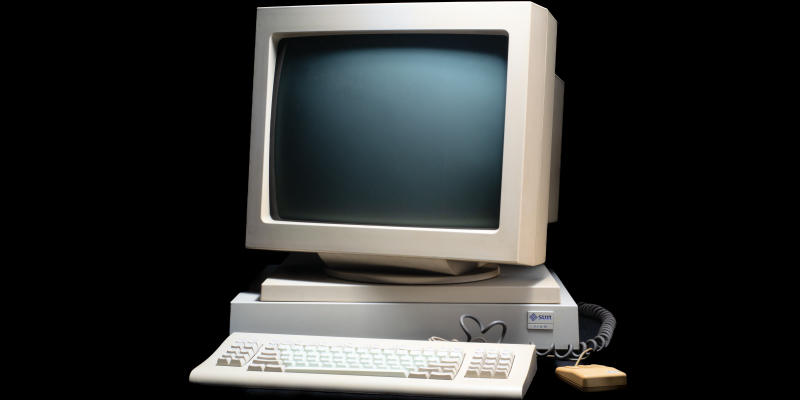
Sun Micro-systems 3/60
A departmental game-changer: a colour graphics card, a mouse, networking capabilities at a cost of £8,000 - £16,000
This machine entered service with the Department of Computer Science at the University of York sometime in 1988-89. These provided a huge improvement to the use of dumb terminals (the VT100), as they were fully fledged computers in themselves.
These machines, in effect, forced out the use of a centralised (main frame) computer. The idea of having your own computer on your desk was amazing at the time. The technology was developing so fast, it was not unusual for a new computer to run twice as fast as the last.
This was the first time the department had a network, opening up the possibility of the internet, which did not exist at the time. The network cable was huge! See the example on show.
A major introduction with the SUN 3 was a 'mouse' for everyday research in the Department. It’s hard to believe that before 1988 a mouse was rarely seen.
The machines changed the way we looked at everyday interactions with computers by bringing in windows and bit mapped graphics at an everyday level.
One reason why the Department did not continue with SUN was the introduction of a new operating system that could not run on the SUN 3 workstations’ 4Mb memory. SUN effectively attempted to force the replacement of the SUN 3's prematurely.
Head of Department, Ian Wand, complained to SUN and they agreed to supply the source code of the SUN operating system. Charles Forsyth changed the new OS software so that it would fit. This allowed the department to continue to use the SUN machines for many years.
However, it was not without problems. Jim Austin wanted to use the rear SCSI connection to link the SUN 3 to a hardware neural network he was researching. After many weeks of trying to access the SCSI link, Charles was asked if he knew what the problem could be. He said, “that's easy, I removed the software from the OS that accessed the SCSI link as no one used it!”
You can imagine how Jim Austin felt.
Related links
The SUN microsystems machines were based on the Motorola 68020 processor running at 20MHz giving in the order of 3 Million Instructions per-second (MIPs). This machine has 24Mbytes of RAM, quite large for the time.
Manufacturer: SUN micro-systems.
- Model 3/60
- RAM 24Mb
- Disk none
- Processor 68020
- MIPs 1.5
This machine has no hard disk in the main unit. SUN promoted networked computing, and all the machines in Computer Science we networked with 'thick' Ethernet, which ran at 10Mbit/s. You could have a local SCSI disk to speed things up. This was the first time the department had a network, opening up the possibility of the internet, which did not exist at the time. The network cable was huge!
The machine has a colour graphics card, an expensive machine at the time. The department mainly used black and white monitors, with quite good resolution (1152x900), and 4Mbytes of RAM (1000x less than we typically find in every day computing in 2022).
A SUN workstation typically cost between £8,000-£16,000.
A major introduction with the SUN 3 was a 'mouse' into everyday research in the Department. Its hard to believe that before 1988 a mouse was rarely seen. We note that the Computer Sheds holds the prototype of the worlds first mass produced commercial mouse as found on the SUN 1 in the collection, which is the oldest preproduction SUN in the world.
To ensure that all the work that Computer Science was doing with the computers was safe backups were used, in addition as disk storage was so expensive meant moving data to large off line storage. To do this required very reliable storage which was relatively low cost. The medium of choice at the time was magnetic tape - a bulk storage method that was very low cost, high capacity and reliable. It’s still used today but with much higher capacity. Here we show a back-up tape drive used in Computer Science. It holds XX bytes of data per full reel.